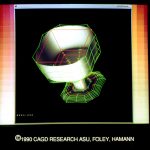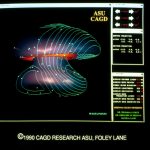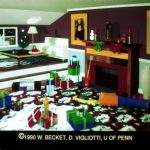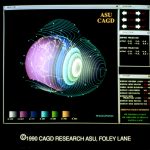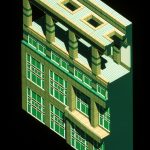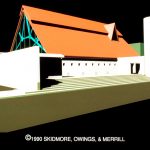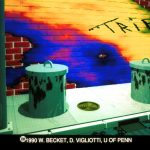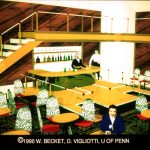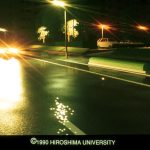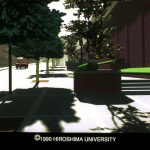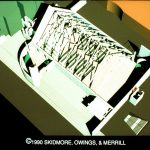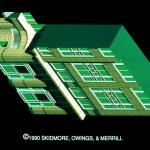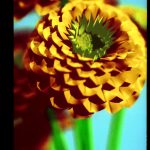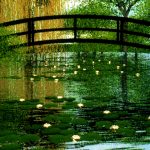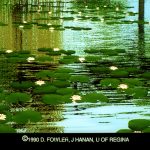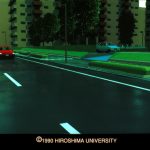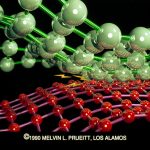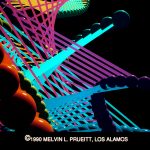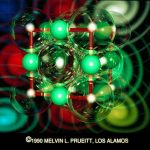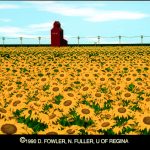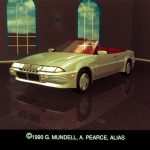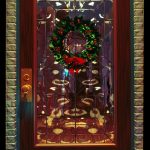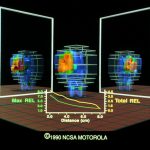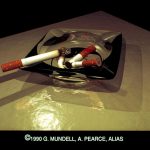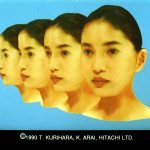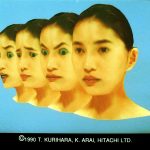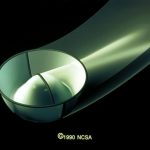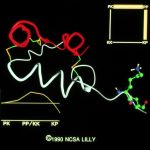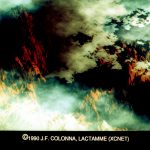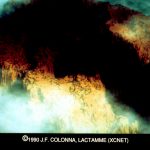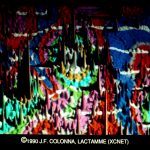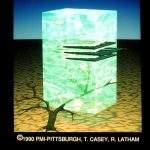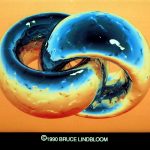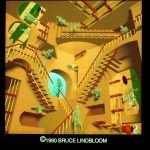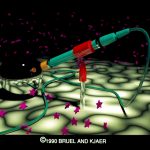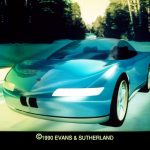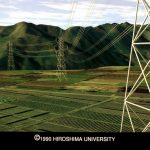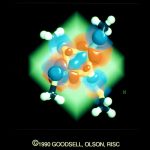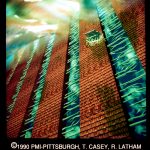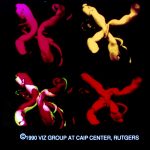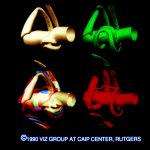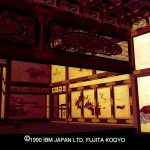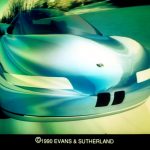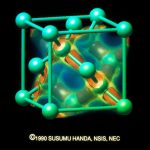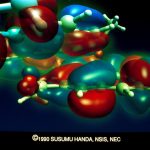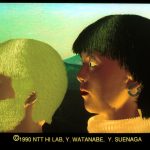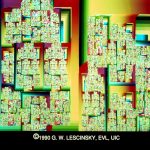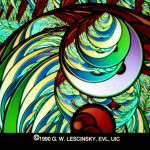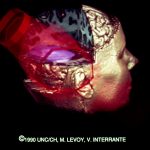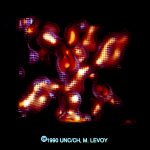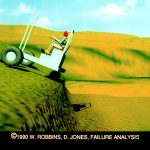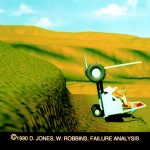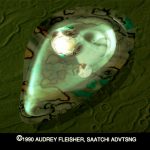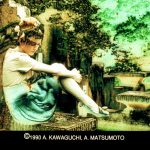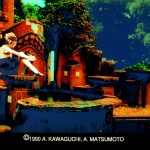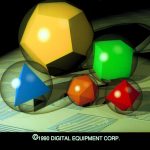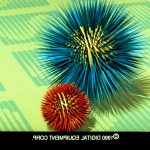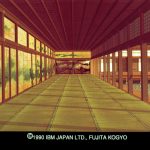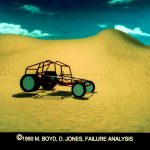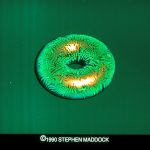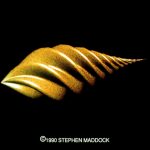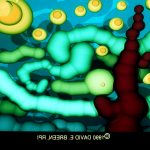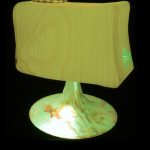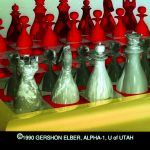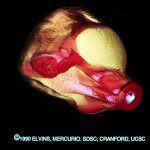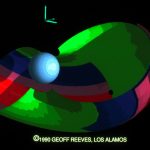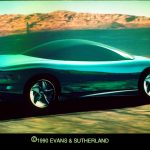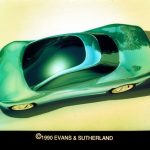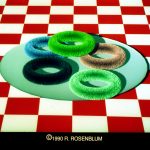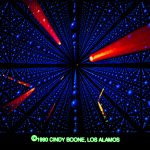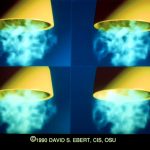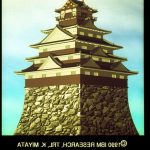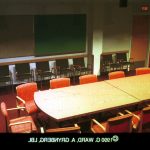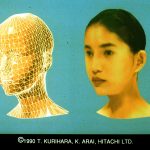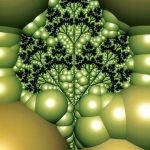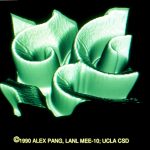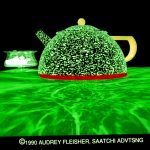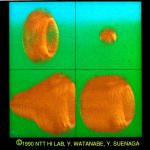“1990 Technical Slide Set”, 1990
Title:
- 1990 Technical Slide Set
Year:
- 1990
Conference:
Description:
SIGGRAPH ’90 Technical Slide Set Credits Edited by Diana Tuggle SIGGRAPH ’90 slide sets chair The technical slide set represents the state-of-the-art in computer- generated images. This year’s set has 78 slides. Each slide is printed here in black and white to facilitate locating information about the images. The full color 35mm slide set can be ordered from: ACM order department, P.O. Box 64145, Baltimore, MD 21264; 1-800-342-6626. The ACM order number for the SIGGRAPH ’90 technical slide set is 915900. The cost is $33 for members; $44 for non-members.
1. Conference Room Comparison by G. Ward and A. Grynberg. The image is a comparison between actual conference room and ray tracing simulation. It was created on a Sun 3/60 and a Dicomed using RADIANCE custom ray tracing program for lighting simulation. Contact: Gregory l. Ward, Lawrence Berkeley Laboratory, I Cyclotron Road, 90-3111, Berkeley, CA 94720, (415) 486-4757.
2. EDO Castle by Kazunori Miyata. The computer-generated stone wall patterns are mapped on the ramparts using IBM C software on the IBM 3081 and IBM 5080. Contact: Kazunori Miyata, IBM Research, Tokyo Research Laboratory, 5-19, Sanbancho, Chiyoda-ku, Tokyo 102, Japan, (03) 288-8248.
3. Chess Set by Gershon Elber. Each chess piece and the board have been modeled using the Alpha-I solid modeler on the Apollo 10000. At no time did the designer have to move individual mesh points. The pawn and bishop are surfaces of revolution whose profiles were designed. All other pieces start as surfaces of revolution and are then modified using “generalized sweeping” and “warping” operators. The cross on the king is the result of an extrusion operation, while the tops of the queen and rook have been modeled using one generalized sweep operation each. It was not feasible to model the knight with conventional operators, so its design made extensive use of the warping deformation operator to push back the head, pull down the face and lift up the ears. Contact: Gershon Elber, Department of Computer Science, University of Utah, Salt Lake City, UT 84112, (801)581-7888.
4. Dolphin Head by T. Todd Elvins, Phil Mercurio, Ted Cranford. This image is a volume rendering of a series of CAT scan slices of a dolphin head. Cranford is studying dolphin anatomy in order to learn more about dolphin sound generation. It was created on a Sun TAAC using VOXVU software. Contact: T. Todd Elvins, San Diego Supercomputer Center-Advanced Scientific Visualization Laboratory, P.O. Box 85608, San Diego, CA 92138-5608, (619) 534-5128.
5. Ion Drifts on the Half Shell by Geoff Reeves. This is a cut-away view of the earth’s radiation belt particles. A satellite is shown in black. Belt colors show paths of various ions. The drift model was generated using FORTRAN on a VAX. Rendering was done on a Macintosh II using “Dimensions.” Contact: Geoff Reeves, Los Alamos National Laboratory, MS D-438, Los Alamos, NM 87545, (505) 665-3877.
6. Car in Desert by Thomas J.V. Malley and Gary Morales. The car was rendered with environment mapping and shadows using CDRS, v. 1.5 on a CDRS-100; background scanned with Eikonix 1412. Contact: Thomas J.V. Malley, Evans & Sutherland, 540 Arapeen Drive, Salt Lake City, UT 84108, (801) 582-5847.
7. Ice Car by Lon Zaback. This car was rendered from overhead with multiple light sources and environment reflections using CDRS, v. 1.5 on a CDRS-100. The background was scanned with an Eikonix 1412. Contact: Lon Zaback, Evans & Sutherland, 540 Arapeen Drive, Salt Lake City, UT 84108, (801) 582-5847.
8. Plate of Furry Doughnuts by Robert Rosenblum. The fur rendering technique developed by the author is substantially faster than recently published volume rendering approaches while maintaining comparable image quality. Each hair is supersampled and scan converted into a z-buffer. Depth maps were used to allow the doughnuts to self shadow. This 1024 x 682 image was rendered in two hours on a HP 9000/370 SRX workstation using software developed by Rosenblum. Contact: Robert Rosenblum, Department of Computer and Information Science, the Ohio State University, 2036 Neil Ave., Columbus, OH 43210, (614) 292-7038.
9. Neutrons Flying Through a Crystal by Cindy Boone. The image shows neutrons flying through a molecular crystalline structure. It was created on a Silicon Graphics computer using Alias software. Contact: Cindy Boone, Los Alamos National Laboratory, MS D416, Los Alamos, NM 87545, (505) 667-4603.
10. Steam and Shadows by David S. Ebert. This slide shows four images of volume rendered steam: the first without any shadows, the second with shadow traced shadows of steam on the glass, the third with shadow traced self shadowing of the gas and on the glass and the fourth with a new shadow table technique for the steam self shadowing and shadows on the glass. The fourth image took less than I 0 percent of the computational time of the third image. The image was created using gas simulation and new rendering algorithm combining volume and scanline a-buffer rendering by the author on a HP 9000 / 370TSRX. Contact: David S. Ebert, CIS Dept., The Ohio State University, 2036 Neil Avenue, Columbus, OH 43210-1277, (614) 228-8412.
11. cAMP Landscape of Slime Molds by Alex Pang. Slime molds are chemotactically attracted by cyclic adenosine monophospate (cAMP). Numerical simulation of this behavior was performed on the connection machine. The mathe- matical model for the slime mold aggregation behavior describes two interrelated and highly nonlinear variables: cAMP concentration and amoeba cell density. This slide illustrates the cAMP concentration for a square “petri dish” on the CM-2 during a particular instant of aggregation. The cAMP landscape shows the cAMP concentration gradients where the slime mold cells tend to move up the steep cliffs. The image was created using in-house and HP-Starbase software on a CM-2 and HP 9000. Contact: Alex Pang, LANL/UCLA, 308 Westwood Plaza, #546, Los Angeles, CA 90024, (213) 454-8582.
12. From the History of Television by Mogens Jacobsen. Demonstrating humor, phong and texture mapping, the image has a resolution of 2K, antialias. It was created using Pansophic’s Studio Works on an Intel 386 and Matrix PCR. Contact: Mogens Jacobsen, ART GRAPH A/ S, Interbase A/S, Dantes Plads I, DK-1556 Kabenhavn V, Denmark, (45) 33 93 28 29.
13. Second Night by David E. Breen. This is a 3-D rendition of Van Gogh’s “Starry Night,” modeled with 150 potential surfaces and ray traced. The Clockworks software was used on a VAXStation II/GPX, E&S PS300, Silicon Graphics IRIS 4D/60, Raster Technologies Model One/380, HP 9000/835, Turbo/SRX and Dunn Instruments Camera 635. Contact: David E. Breen, Rensselaer Design Research Center, CII 7015, Rensselaer Polytechnic Institute, Troy, NY 12180-3590, (518) 276-6482.
14. Fractal Carrot Leaf by Daryl Hepting. This carrot leaf was generated using iterated function/ systems rendered as a set of ray traced spheres representing distance from the fractal. Modeling was accomplished using University of Regina in-house software, and rendering was done with Rayshade by Craig Kolb of Yale. Silicon Graphics IRIS workstations and MIPS M-120 computers were used. Contact: Daryl Hepting, University of Regina, Regina, Saskatchewan, Canada, S4S 0A2, (306) 585-4061.
15. The Pine Corridor in the Edo Castle by Masaki Aono and Tosiyuki Kihara. Attribute mapping was used with a rendering subroutine package and COMPASS on an IBM 3090. Contact: Masaki Aono, IBM Japan Ltd., 5-19 Sanbancho, Chiyoda-ku, Tokyo 102 Japan, (81) 3-828-8244.
16. Dune Buggy Roll Over 3 by Michelle Boyd, Don Jones and Tara Khatua. Scene three in a sequence of five frames depicts a dune buggy rolling down a bump mapped B- s pl in e sand dune. Wavefront software was used on a Silicon Graphics 4D 120 GTX. Contact: Engineering Animation, Failure Analysis Associates, 149 Commonwealth, Menlo Park, CA 94025, (415) 326-9400.
17. Torus 16: Topazmoire Afrique by Stephen C. Maddock. A finely subdivided three-dimensional texture field creates Moire-like fringes on the surface of the torus. The image was created using in- house software on a RM Nimbus PC with Ikon 24-bit pixel engine frame buffer. Contact: Stephen C. Maddock, Sheffield University, The Graphics Lab, Department of Computer Science, Portobello Centre, Pitt Street, Sheffield Sl4DD United Kingdom, (0742) 768555 ext. 5592.
18. Spiral 90 by Stephen C. Maddock. A cylinder is corrugated, twisted and tapered to create a shell- like object. The artist’s own in-house software was used on a RM Nimbus PC with Ikon 24-bit pixel engine frame buffer. Contact: Stephen C. Maddock, Sheffield University, The Graphics Lab, Department of Computer Science, Portobell Centre, Pitt Street, Sheffield S 14DD United Kingdom, (0742) 768555 ext. 5592.
19. Thorny Problem by Stephen Harrison and Jorge Stolfi. This image demonstrates some of the capabilities of the ZZ-buffer algorithm. This algorithm provides many of the rendering capabilities found in ray tracing algorithms and is substan- tially faster, especially for complex scenes. Antialiasing, shadows with real penumbrae and depth-of- field effects are all supported through the use of stochastic sampling. This image contains a pair of procedurally generated objects that were designed in order to test the effectiveness of the stochastic sampling used to perform antialiasing. The image was computed on a DECstation 3100 at a resolution of 800×600 and was recorded using a Matrix QCR-Z film recorder. Contact: Stephen Harrison, Digital Equipment Corporation, 100 Hamilton Ave., Palo Alto, CA 94301, (415) 853-6747.
20. Platonic Relationships by Stephen Harrison and Jorge Stolfi. This image demonstrates some of the capabilities of the ZZ-buffer algorithm. This algorithm provides many of the rendering capabilities found in ray tracing algorithms and is substantially faster, especially for complex scenes. Antialiasing, shadows with real penumbrae and depth-of-field effects are all supported through the use of stochastic sampling. The Digital logo was created using a paint program and then used as a texture map and a bump map in order to produce the embossed surface. The image was computed on a DECstation 3100 at a resolution of 800×600 and was recorded using a Matrix QCR-Z film recorder. Contact: Stephen Harrison, Digital Equipment Corporation, 100 Hamilton Ave., Palo Alto, CA 94301, (415) 853-6747.
21. D-graphy series, Opera Arias by Azuma Kawaguchi and Akihiko Matsumoto. The “D-graphy” technique adds a digital treatment to Silver-Salt photography. It combines the efforts of photographer, stylist, hair and make-up artist, flower designer, model and computer graphics designers. Super Tableau software was used on a NEC PC-9801 RA2 and Sapience Corp. Super Frame2. Contact: Azuma Kawaguchi and Akihiko Matsumoto, 2-16-12 Hanakoganei- Minami-Cyo, Kodaira-si, Tokyo I 87, Japan, (0424) 62-2205.
22. D-graphy series, Opera Arias by Azuma Kawaguchi and Akihiko Matsumoto. The ”D-graphy” technique adds a digital treatment to Silver-Salt photography. It combines the efforts of photographer, stylist, hair and make-up artist, flower designer, model and computer graphics designers. Super Tableau software was used on a NEC PC-9801 RA2 and Sapience Corp. Super Frame2 . Contact: Azuma Kawaguchi and Akihiko Matsumoto, 2-16-12 Hanakoganei- Minami-Cyo, Kodaira-si, Tokyo 187, Japan, (0424) 62-2205.
23. Forklift by Don Jones, Wendy Robbins and Tara Khatua. This is frame one of three images simulating a forklift sliding off a hill. It was created using Wavefront software on a Silicon Graphics 4D 120/GTX. Contact: Engineering Animation, Failure Analysis Associates, 149 Commonwealth, Menlo Park, CA 94025, (415) 326-9400.
24. Forklift by Don Jones, Wendy Robbins and Tara Khatua. This is frame three of three i mages simulating a forklift sliding off a hill. It was created using Wavefront software on a Silicon Graphics 4D 120/GTX. Contact: Engineering Animation, Failure Analysis Associates, 149 Commonwealth, Menlo Park, CA 94025, (415) 326-9400.
25. Oyster I by Audrey Fleisher. The texture mapped image was created on a DEC Micro PDP II and Compusystems Pacesetter 386 using Images II+ software by CGL, Inc. It was then transferred and processed using Rio and Vista Tips, and the 3-D model was created in Crystal on the 386. Contact: Audrey Fleisher, Saatchi and Saatchi Advertising, Inc., 375 Hudson Street, New York, NY 10014, (212) 463-3722.
26. Speckled Kettle by Audrey Fleisher. The texture mapped image was created on a DEC Micro PDP II and Compusystems Pacesetter 386 using Images II+ software by CGL, Inc. It was then transferred and processed using Rio and Vista Tips, and the 3-D model was created in Crystal on the 386. Contact: Audrey Fie Advertising, Inc., 375 Hudson Street, Ne 463-3722.
27. Boxy IFS by Gordon Lescinsky. This escape-time rendering of iterated function system was created on an AT T Pixel Machine using Pixel Machine DEVtools and PY-WAVE scientific visualization software. Contact: Gordon Le scinsky, Electronic Visualization Laboratory, University of Illinois at Chicago, Box 4348, M/C IL 60680, (312) 996-3002.
28. Bubble IFS by Go rdon Lescinsky. This escape-time rendering.of iterated function system was created on an AT T Pixel Machine using Pixel Machine DEYtools and PY-WAVE scientific visualization software. Contact: Gordon Lescinsky, Electronic ? Visualization Laboratory, University of 4348, M/C 154, Chicago, IL 60680, (31
29. Volume Visualization for Radiation Treatment Planning by Marc Levoy and Victoria Interrante. This image is a volume rendering of a 256 x 256 x I09 voxel magnetic resonance (MR) scan of a live human subject. A polygonally defined target volume (in purple) and three treatment beams (in red) have been added using a hybrid ray tracer capable of handling both polygon and volume data. A portion of the volume has been clipped away and the raw MR values have been mapped onto the exposed surfaces. This is a sample? visualization, not a clinical study; the MR data and treatment plan were taken from two different patients. The author’s experimental volume rendering software was used on a DEC 3100 workstation and Adage frame buffer. Contact: Marc Levoy and Victoria Interrante, University of North Carolina at Chapel Hill, Department of Computer Science, Chapel Hill, NC 27599, (919) 962-1975.
30. Volume Rendering of Isoelectron Density Surfaces in Ribonuclease by Marc Levoy. This is a volume rendering of two isodensity contour surf;ices from a portion of an electron density map of Staphylococcus Aureus ribonu- clease. To improve the perception of two distinct surfaces, the opacity of the outer surface alternates between complete transmission and complete attenuation based on the value of a solic texture composed of a filtered honeycomb of small rectangular cells. Contact: Marc Levoy, University of North Carolina at Chapel Hill, Department of Computer Science, Chapel Hill, NC 27599, (919) 962-1975.
31. Electron Density of Silicon Crystal by Susumu Handa. An improved volume rendering algorithm illustrates electron density in silicon crystal as iso-value surface with multi-colored cloud. The image was created using VRMS on an Apollo DN I 0000. Contact: Susumu Handa, NEC Scientific Information System Development, Ltd., 34 Miyukigaoka, Tsukuba, lbaraki 305, Japan, (298) 56-6155.
32. Molecular Orbital in CHL2 by Susumu l:landa. A molecular orbital in CHL2 is shown as iso-value surfaces with yellow mist illustrated by volume rendering. The image was created using VRMS on an Apollo DNI0000. Contact: Susumu Handa, NEC Scientific Information System Development, Ltd., 34 Miyukigaoka, Tsukuba, lbaraki 305, Japan, (298) 56-6155.
33. For Future by Yasuhiko Watanabe and Yasuhito Suenaga. Hair, eyebrows, eyelashes, beard, mustache, earring and hair accessory are modeled by the trigonal prism and wisp model. The image was created using in-house software for human image generation on a SGI IRIS 4D/l 20 GTX. Contact: Yasuhiko Watanabe and Yasuhito Suenaga, NTT Human Interface Laboratories, 1-2356, Take, Yokosuka-Shi, Kanugawa 238-03, Japan, (81) 468-59-4735.
34. Woolly Objects by Yasuhiko Watanabe and Yasuhito Suenaga. Textures and shapes are controlled by the trigonal prism and wisp model. The image was created using in-house software for woolly object generation on a SGI IRIS 4D/120 GTX. Contact: Yasuhiko Watanabe and Yasuhito Suenaga, NTT Human Interface Laboratories, 1-2356, Take, Yokosuka-Shi, Kanugawa 238-03, Japan, (81) 468-59-4735.
35. Vortex Tube Reconnections by D. Silver and Z. Gu. Shown are morphologies in asymmetric, orthogonally offset vortex tube interactions, three time steps (iso- surface ). Lower left image is the composite of three with transparency rendering. In-house DAVID (2D&3D) visualization and diagnostics package was used on an ARDENT TITAN. Contact: D. Silver and Z. Gu, CAIP Center, Busch Campus, Rutgers University, New Brunswick, NJ 08903, (201) 932-5546.
36. Vortex Tube Interactions by D. Silver and Z. Gu. Shown are morphologies in asymmetric, orthogonally offset vortex tube interactions, three time steps (iso- surface). Lower left image is the composite of three with transparency rendering. In-house DAVID (2D&3D) visualization and diagnostics package was used on an ARDENT TITAN. Contact: D. Silver and Z. Gu, CAIP Center, Busch Campus, Rutgers University, New Brunswick, NJ 08903, (201) 932-5546.
37. The Great Hall in the Edo Castle by Masaki Aono and Toshiyuki Kihara. Attribute mapping was used to create the openwork grid patterns. The image was created using rendering subroutine package and COMPASS software on an IBM 3090. Contact: Masaki Aono, IBM Japan Ltd., 5-19 Sanbancho, Chiyoda-ku, Tokyo 102, Japan, (81) 3-828-8244.
38. Screamer by Gary Morales and Norman Angerhofer. This is a rendering with exaggerated field of view and stretched environment for illusion of speed, using environment mapping, shadows and transparency. It was created using CDRS, v. 1.5 on a CDRS-100. The background was scanned with Eikonix 14 I 2. Contact: Norman Angerhofer, Evans & Sutherland, 540 Arapeen Drive, Salt Lake City, UT 84108, (801) 582-5847.
39. Blue Car On Winter Road by Gary Morales and Norman Angerhofer. This realistic rendering with environment mapping, shadows and transparency took about one minute to render. It was created using CDRS, v. 1.5 on a CDRS-100. The background was scanned with Eikonix 1412. Contact: Norman Angerhofer, Evans & Sutherland, 540 Arapeen Drive, Salt Lake City, UT 84108, (801) 582-5847.
40. Transmission Lines by Eihachiro Nakamae, Kazufumi Kaneda, Haruhiko Iriyama, Manabu Kato. Very thin objects such as transmission lines are modeled as patterns on transparent planes and are antialiased by using a multi-scanning method. In-house software was used on a Sequent S8 l and IRIS 4D. Contact: Eihachiro Nakamae, Hiroshima University, Electric Machinery Laboratory, Saijo-cho, Higashi-hiroshima 724, Japan, (81) 824-22-7111.
41. QM by David Goodsell and Arthur Olson. This is a volume rendered view of quantum mechani- cal data. It was created using in- house software (RMSYOLUME) on a Stellar. Data was courtesy of Lou Noodleman. Contact: David Goodsell and Arthur Olson, Research Institute of Scripps Clinic, MB-5, I 0666 N. Torrey Pines Road, La Jolla, CA 92037, (619) 554-4392.
42. Compass Series #2 (Walls) by Tom Casey and Renee Latham. Displacement mapped geometry was used to create storm clouds. The image was created using Alias, Artisan, 42 Inc. software on a Silicon Graphics 4D/60. Contact: Tom Casey, Production Masters, Inc., 321 First Ave., Pittsburgh, PA I 5222, ( 412) 281-8500.
43. Compass Series #3 (Cube) by Tom Casey and Renee Latham. This is a combination bump, reflection, color, transparency map created from fractal based variables. The artists used Alias, Artisan, 42 Inc. software on a Silicon Graphics 4 D/60. Contact: Tom Casey, Production Masters, Inc., 321 First Ave., Pittsburgh, PA 15222, (412) 281- 8500.
44. Unity by Bruce J. Lindbloom. The image was inspired by the American Sign Language sign for unity. A procedural bump function was used to produce the unusual surface texture. A stochastic ray tracer written by the author was used. The image was rendered on a DECstation 3100 at 4K resolution and filmed on a Dicomed D48 film recorder. Contact: Bruce J. Lindbloom, 7370 Walnut Court, Eden Prairie, MN 55346, (612) 937-9627.
45. Relativity’s Relative by Bruce J. Lindbloom. This is an interpre- tation of M.C. Escher’s 1953 “Relativity” image, one of the few Escher illusions that can be modeled by normal 3D geometry. The scene contains 1,528 objects and was rendered using constructive solid geometry, procedural textures and four area light sources. Contact: Bruce J. Lindbloom, 7370 Walnut Court, Eden Prairie, MN 55346, (6 I 2) 937-9267.
46. Untitled by Bruce J. Lindbloom and Mike Newman. A ring of 500 stars surrounds this ray traced design used by Brue! and Kjaer for a compact disc cover. The microphone cord is a thickened, piecewise cubic spline. The image was rendered on a DECstation 3 !00 at 4K resolution and filmed on a Dicomed D48 film recorder using a stochastic ray tracer written by Lindbloom. Contact: Bruce J. Lindbloom, 7370 Walnut Court, Eden Prairie, MN 55346, (612) 937-9267.
47. Fractal Landscapes by Jean- Francois Colonna. The fractal landscapes were created on a Bull DPX 5000 using UNIX and C and the author’s own graphical software. Contact: Jean-Francois Colonna, Lactamme, Ecole Polytechnique, 91128 Palaiseau Cedex, France, (33) 1-60-19-40-53.
48. Fractal Landscapes by Jean- Franco is Colonna. The fractal landscapes were created on a Bull DPX 5000 using UNIX and C and the author’s own graphical software. Contact: Jean-Francois Colonna, Lactamme, Ecole Polytechnique, 91128 Palaiseau Cedex, France, (33) 1-60-19-40-53.
49. Wavelet Transform by Jean- Francois Colonna. This slide shows a 3-D visualization of the wavelet transform of a 2-D fractal field. The surface shows the field, the colors display the module and the white lines give the phase. The image was created on a Bull DPX 5000 using UNIX and C and the author’s own graphical software. Contact: Jean-Francois Colonna, Lactamme, Ecole Polytechnique, 91128 Palaiseau Cedex, France, (33) 1-60-19-40-53.
50. Synthetic Faces by Tsuneya Kurihara and Kiyoshi Arai. This 3-D model of a human face is reconstructed from 2-D pictures. Multiple textures are mapped for realistic rendering. The left shows constant shading; the right is texture mapped. The image was created using in-house software for facial animation on a HP9000, 835 TURBO SRX. Contact: Tsuneya Kurihara and Kiyoshi Arai, Central Research Laboratory, Hitachi, Ltd., Kokubunji, Tokyo I 85, Japan, (0423) 23-1111.
51. Synthetic Faces by Tsuneya Kurihara and Kiyoshi Arai. This 3-D model of a human face is reconstructed from 2-D pictures. Multiple textures are mapped for realistic rendering. Four views. The image was created using in-house software for facial animation on a HP9000, 835 TURBO SRX. Contact: Tsuneya Kurihara? and Kiyoshi Arai, Central Research Laboratory, Hitachi, Ltd., Kokubunji, Tokyo 185, Japan, (0423) 23-1111.
52. Synthetic Faces by Tsuneya Kurihara and Kiyoshi Arai. This 3-D model of a human face is reconstructed from 2-D pictures. Multiple textures are mapped for realistic rendering. Three facial expressions are shown. The image was created using in-house software for facial animation on a HP9000, 835 TURBO SRX. Contact: Tsuneya Kurihara and Kiyoshi Arai, Central Research Laboratory, Hitachi, Ltd., Kokubunji, Tokyo 185, Japan, (0423) 23-1 I I I.
53. Energy Density of Higgs Field at the Time of Inflation by Dan Brady, Matthew Arrott, Mark Bajuk, David Schramm, Larry Smarr, David Hobill. This slide depicts the effective potential energy for the universe at the time of inflation, with a history of its change as the universe cools. It was created using Wavefront Technologies and in-house software on a SGI 240 GTX. Contact: Dan Brady, National Center for Supercomputing Application, 152 Computing Application Building, 605 E. Springfield Ave., Champaign, IL 61820, (217) 244-2003.
54. Computational Modelling of Insulin Analogs by Dan Brady, William Sherman, Mark Baj uk, James T. Metz, James E. Shields, David Gorenstein, Claude Jones. The gibbs free energy simulation demonstrates a molecule transitioning to a new form. This correlated value relates to the molecule tendency toward self associativity. The image was created using Wavefront Technologies and in-house software on a SGI 240 GTX. Contact: Dan Brady, National Center for Supercomputing Application, 152 Computing Application Building, 605 E. Springfield Ave., Champaign, IL 6 I 820, (2 I 7) 244-2003.
55. Untitled by Dan Brady, Michael McNeill, H. Chuang. This image exploits our common experience with mirrors to make the process of mentally recontructing this complex object much easier. It was created using Wavefront Technologies and in-house software on a SGI 240 GTX. Contact: Dan Brady, National Center for Supercomputing Application, 152 Computing Application Building, 605 E. Springfield Ave., Champaign, IL 61820, (217) 244-2003.
56. Ashtray by Gary Mundell and Andrew Pearce. Ashtray made of trimmed surfaces is ray traced with transparent shadow attenuation and recursive uniform spatial sub- division. Alias/2 ray tracing software was used on a SGI 4D/25. Contact: +1?1 :.,:y;,s .PH Gary Mundell, Alias Research Inc., 110 Richmond Street East, Toronto, Ontario, Canada, ( 416) 362- 9181.
57. Convertible Grand Prix Prototype by Gary Mundell, Mark Adams, Andrew Pearce. 200,000 triangles were ray traced with 20 light sources with incandescent “fractal” headlights. The image was created with Alias/2 ray tracing on a SGI 4D/25. Contact: Gary Mundell, Alias Research Inc., 110 Richmond Street East, Toronto, Ontario, Canada, ( 4 I 6) 362-9 I 81.
58. Rosedale by Gary Mundell, P. Roy, Andrew Pearce. This ray tracing is on an entirely modeled scene (the hallway is not just a backdrop), procedural wood and fractally bumped glass. The image was created with Alias/2 ray tracing on a SGI 4D/25. Contact: Gary Mundell, Alias Research Inc., I IO Richmond Street East, Toronto, Ontario, Canada, ( 416) 362-9181.
59. Super Lattice by Melvin L. Prueitt. This ray tracing illustrates problems of fitting together of crystal layers with different lattice constants. It was created with the author’s SCOPE software on a Cray computer and Dicomed film recorder. Contact: Melvin L. Prueitt, Los Alamos National Laboratory, MS-B272, Los Alamos, NM 87544, (505) 667-4452.
60. Magellanic Antanae by Melvin L. Prueitt. This rendering of cylinders and spheres was created with the author’s SCOPE software on a Cray computer and Dicomed film recorder. Contact: Melvin L. Prueitt, Los Alamos National Laboratory, MS-B272, Los Alamos, NM 87544, (505) 667-4452.
61. Palladium Deuteride by Melvin L. Prueitt. This ray tracing and texture mapping of transparent spheres represents palladium atoms. Turquoise spheres represent deuterium atoms. The image was created with the author’s SCOPE software on a Cray computer and Dicomed film recorder. Contact: Melvin L. Prueitt, Los Alamos National Laboratory, MS-B272, Los Alamos, NM 87544, (505) 667-4452.
62. Sunflower Field I by Deborah Fowler, N. Fuller, J. Hanan, A. Snider. A ray traced field of flowers was generated using L-systems. The scene contains approximately 800,000,000 polygons. Modeling software was in-house, and Rayshade by Craig Kolb of Yale was used for rendering. Silicon Graphics IRIS workstations and a MIPS M-120 computer were used. Contact: Deborah Fowler, Department of Computer Science, University of Regina, Regina, Saskatchewan, Canada S4S 0A2, (306) 585-406 I.
63. Zinnia F l owerheads by Deborah Fowler, A. Snider, P. Prusinkiewicz. The image shows ray traced heads of zinnia flowers exhibiting spiral phyllot actic patterns. Modeling software was in- house, and Rayshade by Craig Kolb of Yale was used for rendering. Silicon Graphics IRIS workstations and a MIPS M-120 computer were used. Contact: Deborah Fowler, Department of Computer Science, University of Regina, Regina, Saskatchewan, Canada S4S 0A2, (306) 585-4061.
64. Waterlilies by Deborah Fowler, J. Hanan, P. Prusinkiewicz, N. Fuller. The waterlilies in this image were based on a geometric model of spiral phyllotaxis while the willow and poplar trees were generated using L- systems. Modeling software was in- house, and Rayshade by Craig Kolb of Yale was used for rendering. Silicon Graphics IRIS workstations and a MIPS M-120 computer were used. Contact: Deborah Fowler, Department of Computer Science, University of Regina, Regina, Saskatchewan, Canada S4S 0A2, (306) 585-4061.
65. Lily Pond by Deborah Fowler, J. Hanan, P. Prusinkiewicz, N. Fuller. The waterlilies in the image were based on a geometric model of spiral phyllotaxis while the willow and poplar trees seen as reflections were generated using L-systems. Contact: Deborah Fowler, Department of Computer Science, University of Regina, Regina, Saskatchewan, Canada S4S 0A2, (306) 585-4061.
66. Road Surface after Rain by Eihachiro Nakamae, Kazufumi Kaneda, Takashi Okamoto, Tomoyuki Nishita. This image shows a novel reflection model of a road surface under various conditions. It was created with in-house software on a Sequent S8I and IRIS 4D. Contact: Eihachiro Nakamae, Hiroshima University, Electric Machinery Laboratory, Saijo-cho, Higashi-hiroshima 724, Japan, (81) 824-22-7111.
67. Lighting Effects on a Wet Road by Eihachiro Nakamae, Kazufumi Kaneda, Takashi Okamoto, Tomoyuki Nishita. This image is a novel model of reflection on a road surface and streaks of light taking into account diffraction of light. It was created with in-house software on a Sequent S8 l and IRIS 4D. Contact: Eihachiro Nakamae, Hiroshima University, Electric Machinery Laboratory, Saijo-cho, Higashi-hiroshima 724, Japan, (81) 824-22-7111.
68. The Shade of Trees by Eihachiro Nakamae, Kazufumi Kaneda, Haruhiko Iriyama, Toshio Akinobu, Shinichi Takita. A shadow model with penumbra effects takes into account the size of the sun. It was created with in-house software on a Sequent S8 l and IRIS 4D. Contact: Eihachiro Nakamae, Hirosh Machinery Laboratory, Saijo-cho, Higa (81) 824-22-7111.
69. Building Base Facade Study by Jim Feeney and Nate Kaiser. This ray traced image at 1800 x 2030 resolution was created on a IBM RT using modeling and rendering programs in the IBM architecture and engineering series. Contact: Nate Kaiser, Skidmore, Owings & Merrill, 33 West Monroe, Chicago, IL 60603; (3 l 2) 641-5959.
70. Church Study by Todd Halamka and Nate Kaiser. This ray traced image at 1024 x 782 resolution was created on the IBM RT using modeling and rendering programs in the IBM architecture and engineering series. Contact: Nate Kaiser, Skidmore, Owings & Merrill, 33 West Monroe, Chicago, IL 60603; (312) 641-5959.
71. Building Top Facade Study by Jim Feeney and Nate Kaiser. This ray traced image at 1800 x 2030 resolution was created on the IBM RT using modeling and rendering programs in the IBM architecture and engineering series. Contact: Nate Kaiser, Skidmore, Owings & Merrill, 33 West Monroe, Chicago, IL 60603; (312) 641-5959.
72. Church Exterior Study by Todd Halamka and Nate Kaiser. This ray traced image at 1024 x 782 resolution was created on the IBM RT using modeling and rendering programs in the IBM architecture and engineering series. Contact: Nate Kaiser, Skidmore, Owings & Merrill, 33 West Monroe, Chicago, IL 60603; (312) 641-5959.
73. Back Street by Welton Becket and Dawn Vigliotti. Textures were generated from natural language commands using techniques outlined in “Imperfection for Realistic Image Synthesis” by Welton Becket and Norman I. Badler. Software: ‘Jack’? Cary Phillips and ray tracing software by Welton Becket. The image was created on a Silicon Graphics IRIS 4D70GT. Contact: Welton Becket and Dawn Vigliotti, University of Pennsylvania Computer Graphics Lab, C. I. S., 200 South 33rd Street, Philadelphia, PA l9l04-6389, (215) 898-1976.
74. The Waterfront Cafe by Welton Becket, Dawn Vigliotti, Pei-Hwa Ho, Jean Griffin. This face texturing through spherical shrinkwrapping onto laser scanned bodies was created on a Silicon Graphics IRIS 4D70GT. Software: ‘Jack’ -Cary Phillips and ray tracing software by Welton Becket. Contact: Welton Becket and Dawn Vigliotti, University of Pennsylvania Computer Graphics Lab, C. I. S., 200 South 33rd Street, Philadelphia, PA 19104-6389, (215) 898-1976.
75. Seasons Greetings by Welton Becket and Dawn Vigliotti. This 1989 graphics lab holiday card was created on a Silicon Graphics IRIS 4D70GT. Software: ‘Jack’ -Cary Phillips and ray tracing software by Welton Becket. Contact: Welton B e cket and D awn Vigliotti, University of Pennsylvania Computer Graphics Lab, C. I. S., 200 South 33rd Street, Philadelphia, PA 19104-6389, (215) 898-1976.
76. Surfaces on Surfaces – Earth by Robert E. Barnhill, Tom Foley, Greg Nielson, David Lane. This image is a color contoured domain, transparent interpolant created on a SGI IRIS 4D 220 GTX. Contact: Robert E. Barnhill, CAGD Research Group, Com p uter Science Department, College of Engineering, ECG 252, Arizona State University, Tempe, AZ 85287-5406, (602) 965-3190. 77. Surfaces on Surfaces – Mushroom by Robert E. Barnhill, Tom Foley, Greg Nielson, David Lane. This smooth shaded domain, transparent interpolant was created on a SGI IRIS 4D 220 GTX. Contact: Robert E. Barnhill, CAGD Research Group ,-Computer Science Department, College of Engineering, ECG 252, Arizona State University, Tempe, AZ 85287-5406, (602) 965 -3190.
77. Surfaces on Surfaces – Mushroom by Robert E. Barnhill, Tom Foley, Greg Nielson, David Lane. This smooth shaded domain, transparent interpolant was created on a SGI IRIS 4D 220 GTX. Contact: Robert E. Barnhill, CAGD Research Group ,Computer Science Department, College of Engineering, ECG 252, Arizona State University, Tempe, AZ 85287-5406, (602) 965 -3190.
78 . Bernd Quartic Tension Product Surface by Robert E. Barnhill, Tom Foley, Bernd Hamann. This image shows a quartic tension product service with tension control; goblet negative tension. This image? was created on a SGI IRIS 4D 220 GTX. Contact: Robert E. Barnhill, CAGD Research Group, Computer Science Department, College of Engineering, ECG 252, Arizona State University, Tempe, AZ 85287-5406, (602) 965 -3190.
Publication Documents:
1990 Technical Slide Set Images:
